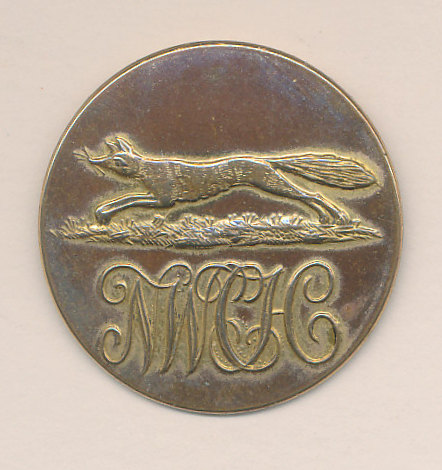Hunt Club Buttons Are Focus of New Jersey State Button Society Show
TALLY HO: This antique button is representative of those that will be on display at the September 14 gathering of the New Jersey State Button Society in Titusville.
By Anne Levin
To the more than 2,300 members of the National Button Society, buttons are tiny treasures that tell a story. At its gathering on September 14 at the Union Fire Company in Titusville, the 83-year-old New Jersey State Button Society will hear stories inspired by a collection of hunt club buttons — used to fasten those scarlet jackets worn during fox hunts.
“Tally Ho! The Hunt is On!” is the presentation that avid collector Johnson Frazier will deliver during the show. A New Jersey native who now lives in Florida, Frazier returns as often as he can for the bi-annual New Jersey show. He plans to bring eight trays of buttons for display, along with a large sample book from the late 19th century.
“It’s a lot of eye candy,” he said. “A lot of stuff to look at.”
Frazier and his wife recently returned from the national convention of the National Button Society in Springfield, Ill. Founded in 1938, the organization’s mission is “educating, enjoying, and preserving all that is beautiful and historic in buttons,” according to its website. Members come from 36 states and 10 countries. In addition, there are more than 150 local button clubs across the country.
Frazier has been amassing buttons since playing the drummer boy in Civil War reenactments at age 10. “I’ve always been interested in history,” he said. “And that’s the appeal of buttons. I primarily collect uniform buttons — police, fire, government organizations — anything like that. Having collected those of all types for many years, it just seemed that hunt club buttons should be on the list as well.”
Among the enthusiastic members of the New Jersey Button Society is Stonebridge resident Barbara Figge Fox, a longtime journalist for the newspaper U.S. 1. Like Frazier, Fox’s fascination started in childhood.
“My grandmother collected buttons in the 1940s, when the hobby of button collecting was new,” she wrote in an email. “I loved helping polish her metal buttons that pictured everything from Red Riding Hood to Joan of Arc. Now her buttons fill my file cabinets and, in frames, they decorate my walls.”
Fox has been helping out at the New Jersey organization’s events since her grandmother’s collection came to her 15 years ago. She also teaches button collecting classes at Princeton Adult School and gives library programs on the subject.
A big part of the appeal of buttons is the artistry that goes into their creation. “The older ones are like little works of art,” said Frazier. “The 18th century French ones, in particular — some are painted under glass. They are actually little portraits.”
Fox said buttons can be made from 48 different materials. “They are the world’s smallest antique, and I find it fascinating to research how each button has a story, starting with why and how it was made,” she said. “Some of my favorites are made from the shells of clams or whelks.”
According to a press release for the upcoming show, “In order to have the privilege of wearing buttons of a particular hunt, one would have to be an approved member of the hunt for some time and invited by the master of the hunt to wear them. Hunts were formed by well-to-do land owners and often had their name or county in which the hunt took place on a button.”
While fox hunts are still held in Britain and the U.S., including several in central New Jersey, they no longer involve the killing of a fox. The hounds chase the fox, “but when the fox goes to ground, that’s it,” Frazier said.
The New Jersey Button Society’s Fall 2024 Show and Competition will be at the Union Fire Company, 1396 River Road in Titusville, from 9 a.m. to 3 p.m. Admission is free. Visit newjerseystatebuttonsociety.com for details.
“Buttons are a ‘politics-free zone’ and offer a way to make lasting friendships,” said Fox. “At local club meetings, we have fun helping each other study how buttons are made.”


